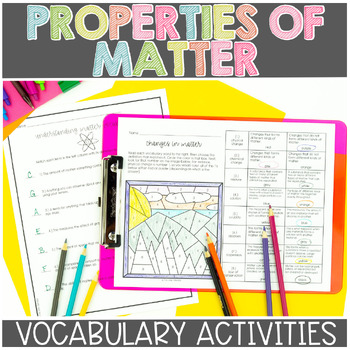Properties of Matter Vocabulary Games Worksheets Activities
- PDF
What educators are saying
Description
Engage your students during science and help them learn those all-important science vocabulary terms with these 6 different games and activities- including practice worksheets!
Check out the preview for details!
Check out the FREEBIE for a small sample of this resource!
Objective:
For students to review the matter terms and their definitions so that they are committed to memory in an engaging way.
This Resource Covers:
This activity uses the following vocabulary terms and their definitions:
- matter
- volume
- mass
- buoyancy
- weight
- density
- physical properties
- gas
- solid
- evaporation (with boiling as an alternative)
- condensation
- melting
- freezing
- physical changes
- chemical changes
- mixture
- solution
- solubility
- dissolve
- suspension
- law of conservation
With this Resource You'll Get:
- 6 Different activities - puzzles, dominoes, the game "Hogwash", the game "Guess It!," Color by Number activity, and vocabulary matching review practice sheets.
- Directions for all games
- Editable versions of the dominoes, hogwash cards, guess it cards, and puzzle pieces
- Answer keys
Learn More About This Resource Here:
5 Activities to Learn Science Vocabulary
Other Resources You May Enjoy:
Physical and Chemical Changes Unit
Printing Notes:
I recommend printing and laminating materials for future use. These materials print just fine in grayscale. I would suggest printing "as image" from Adobe rather than your browser to avoid any potential issues.
☞Mistakes Happen!☜
If you see ANYTHING that needs modifying, or if you have any questions, please contact me via the Q&A. I take my product creation and your satisfaction very seriously! Thanks!
⭐Earn FREE Resources! ⭐
It's very important to me that you provide feedback so that I may improve and create products you will use and love! Please consider leaving detailed feedback. Additionally, each time you provide feedback, you earn TpT credits. These can be taken off purchases so you can get items free!
❤️Love What You See? ❤️
Join my email list here to get FREEBIES and so much more!
Follow my store here to get discounted goodies each time they're posted!
keywords: states of matter, matter, physical properties of matter, separating mixtures, mixtures and solutions, matter vocabulary, physical and chemical changes, investigating matter, conservation of mass, solid liquid gas, changes in matter, chemical reactions, matter games, properties of matter worksheets, matter worksheets, matter review, physical and chemical changes properties





